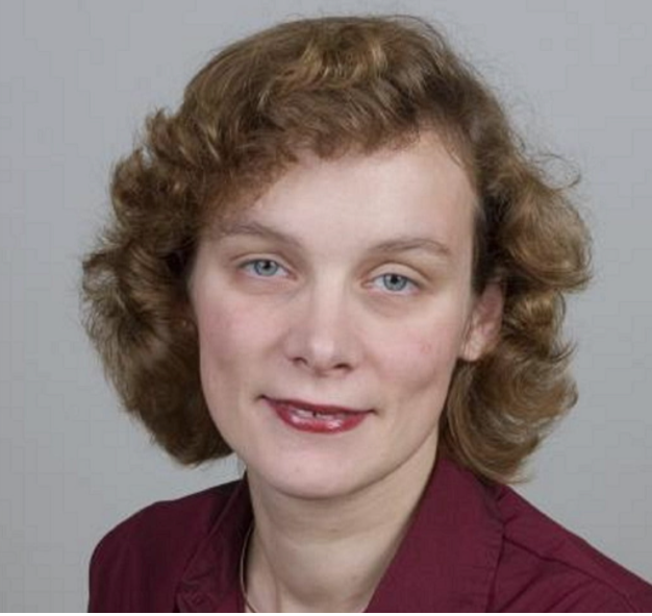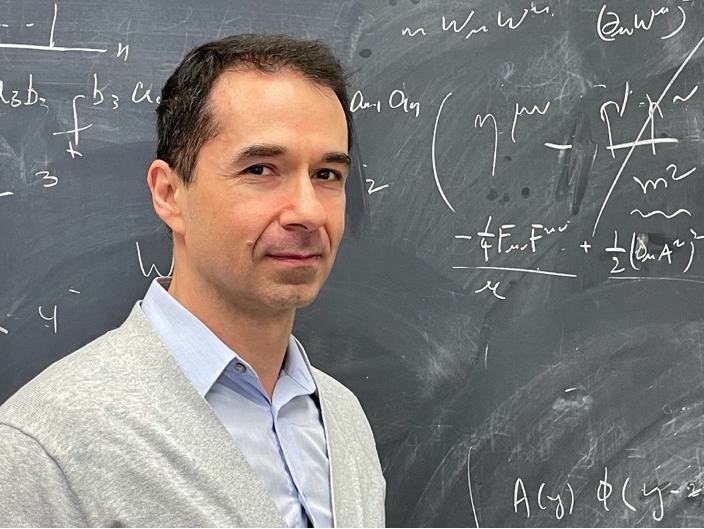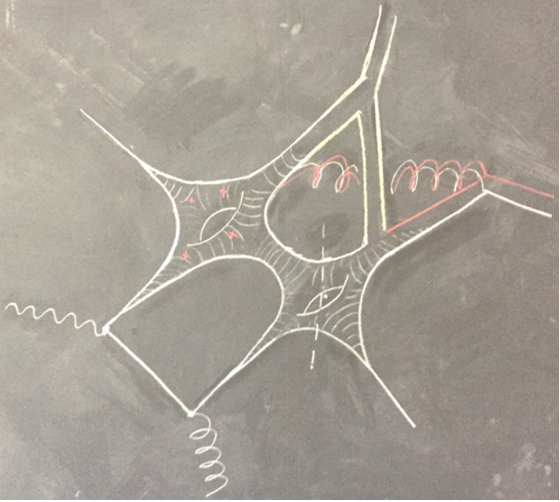KITP Postdoctoral Scholars Helped Create a New Field in Physics
 Anastasia Volovich, Brown University Professor and former KITP postdoctoral scholar
Anastasia Volovich, Brown University Professor and former KITP postdoctoral scholar
 Radu Roiban, Penn State Professor and former UCSB postdoctoral scholar
Radu Roiban, Penn State Professor and former UCSB postdoctoral scholar
At KITP, postdoctoral scholars (i.e., postdocs) enjoy exceptional intellectual freedom, and every year they have access to over 1,000 leading scientists who convene for the institute’s programs and conferences. Not only does this benefit the postdocs, but integrating these early-career scientists into programs catalyzes scientific breakthroughs like one that took place at the 2004 “Collider Physics” program.
Focused on particle physics and collider phenomenology, “Collider Physics” was to be well outside of Anastasia Volovich’s field of interest. Volovich, now a professor at Brown, was a second-year string theory postdoc. “The program was supposed to be on Collider Phenomenology, completely outside my field. . . If somebody told me about this program when I just arrived at KITP I would have thought okay, this is not my field, but maybe I will go to a couple of talks,” she admits.
Then, a month before the program, something happened that changed the course of her career, as well as an entire sub-field of science. In December 2003, particle physics collided with string theory when Professor Ed Witten (Institute for Advanced Study) published a groundbreaking paper called “Perturbative Gauge Theory as a String Theory in Twistor Space.” The work applied ideas from string theory to the mathematical structure of scattering amplitudes, predictions that calculate the likelihood that when two particles collide, other particles form.
With the release of Witten’s paper, the physics community was crackling with creative energy, and in Santa Barbara, three early-career scientists—KITP postdocs Anastasia Volovich and Marcus Spradlin, and UCSB physics postdoc Radu Roiban—were particularly inspired.
Roiban, who was in his last year of his postdoc and interviewing for his next position, scrambled to attend. KITP and the program coordinators responded quickly, as well—the focus shifted largely toward ideas related to the December 2003 paper, which Roiban says “shook the field.” Witten accepted a last-minute invitation to visit, string theorists and particle physicists descended on Santa Barbara, and the connection began to gel. Volovich recounts: “That paper happened in December, and in January he actually came to KITP for a few days to give a talk, and that’s where the whole interaction started happening between these two communities [string theorists and collider phenomenologists], and a lot of new insights came out of it. “ Volovich, Roiban, and Spradlin made rapid strides. “[Witten] proposed the framework and described some examples,” Radu explains, “We showed that the framework described in his paper applies to essentially all scattering amplitudes.” Their work provided a key element to the conversation.
“For the longest time there were two distinct fields, scattering amplitudes and integrability,” Roiban recalls. “A lot of people were talking about more or less the same few theories, but there were no direct relations between the methods and the questions that were asked.” At first, the fields seemed disconnected from each other, but ties quickly emerged, which over time were developed and clarified into a larger framework.
Volovich reflects on her KITP postdoc experience as a uniquely productive time: “It was certainly the best time in my career. On one hand, I didn’t have to teach or have committee responsibilities, because I wasn’t faculty; on the other hand, I was not a graduate student, and so I could work on my own ideas, so I totally switched [fields].”
Roiban believes that the circumstances Volovich describes makes the postdoc phase an ideal time to develop big ideas. “They basically have the ability to be incredibly productive with very little restraint, which is obviously incredibly valuable to the field.”
 2017 Scattering Amplitudes and Beyond program logo. Radu Roiban was a coordinator and COLLIDER04 coordinator Zvi Bern was a scientific advisor. The program was one of several that have continued investigating ideas developed in 2004.
2017 Scattering Amplitudes and Beyond program logo. Radu Roiban was a coordinator and COLLIDER04 coordinator Zvi Bern was a scientific advisor. The program was one of several that have continued investigating ideas developed in 2004.
He also believes that being at KITP and UCSB positions postdocs perfectly to make huge breakthroughs: “Something extremely valuable is that UCSB and KITP . . . have great faculty, who when the postdocs get stuck on something where they need a little bit of help or just a point in the right direction, they have somebody to actually walk to their office and explain what the problem is and more often than not, they get they get the right push in the right direction.”
The unique design of programs at KITP – where experts in the field can be physically present together for weeks or months at a time – was a key component in Volovich, Roiban, and Spradlin’s success. “There are things that go so much faster when people are in front of a blackboard and they argue and they fight and then they eventually all agree on the right answer,” Radu explains. “It leads to something, in our case, fairly interesting.”
The “Collider Physics” program contributed to the emergence of a new sub-field of physics, and early-career scientists played a key role. "The most amazing thing [about this program] was that a large number of new, young people who had never really been interested in this area before moved into it, and just gave a much greater amount of ferment and vitality to the field,” confirms program participant (and former KITP Advisory Board member) Lance Dixon (SLAC).
As the field has evolved, connections to still more areas of inquiry have emerged, and KITP continues to nurture them. Scientists in the fields of gravitation have joined the conversation, and the program “High-Precision Gravitational Waves,” in Spring 2022, will bring them together with the field theory community that the 2004 program helped to shape. “It's hard to put a number on it,” Roiban says, “but I'm willing to bet that without the programs that KITP organizes, the field as a whole would be back at least 10 years.”
by Maggie Sherriffs and Megan Turley
